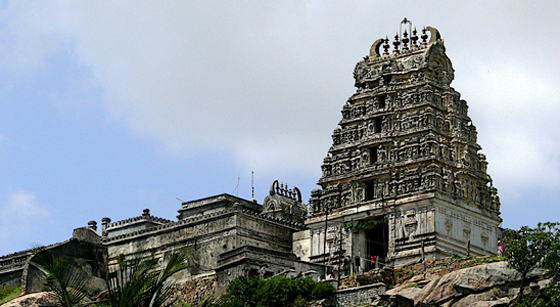Melkote is a small town located in the Mandya district of the southern state of Karnataka, India. It is situated about 50 kilometers northwest of the city of Mysore. Melkote is known for its historical and religious significance and is considered to be an important pilgrimage site for Hindus.
The town is home to the Cheluvanarayana Temple, which is dedicated to Lord Vishnu and is considered to be one of the most important Vaishnavite temples in South India. The temple was built in the 12th century by the Hoysala dynasty and is known for its intricate carvings and sculptures. The temple is also home to a number of inscriptions and manuscripts that provide insight into the history and culture of the region.
Melkote is also known for its beautiful natural surroundings, including the nearby Yoganarasimha Hill and the Thirunarayanapura Dam. The town is also an important center of the Sri Vaishnavism tradition and attracts many scholars and devotees from around the country.
Melkote can be reached by bus or train from nearby cities like Mysore and Bangalore. The nearest airport is Kempegowda International Airport in Bengaluru, which is about 140 kilometers away from Melkote.
Melkote is an important pilgrim center that is about 51 km from Mysore and 133 km from Bangalore. It lies in Pandavapura taluk of Mandya district. According to mythology, the Melkote was known as Narayanadri, Vedadri, Yadavadri, Yathishaila, and Thirunarayanapura as the temple of Narayanaswamy is built on a granite rocky hill that comprises some of the oldest rock formations on earth known as Yadavagiri or Yadugiri overlooking the Cauvery valley. Melkote is very well known for various famous temples and a festival called Vairamudi.
It is a sacred pilgrim center for Sri Vaishnavas. Legend has it that in the early 12th century was a time of great rivalries between Shaiva and Vaishnava sects in South India. Vaishnavas were persecuted by the Cholas, who were the rulers of Tamilnadu at that time. Sri Ramanujacharya, the leading preacher of Vaishnavism had to escape from Chola rule. He was allowed to live in exile at Melkote by then Hoysala ruler Vishuvardhana. Influenced by Sri Ramanujacharya, Vishuvardhana who was Jain converted to Vaishnavism. During the 14th century, the defeat of Hoysala Kings against Muslim forces saw the destruction of Melkote. The town was plundered by the invaders. It was later restored during Vijayanagar rule.
Cheluvanarayana Swamy Temple
The temple is dedicated to Lord Vishnu, specifically to his incarnation as Cheluvanarayana. It is considered to be one of the most important Vaishnavite temples in South India and is a major pilgrimage site for followers of the Sri Vaishnavism tradition.
The temple is believed to have been built in the 12th century by the Hoysala dynasty, and is known for its intricate carvings and sculptures, including those of Lord Vishnu and his consort, Goddess Lakshmi. The temple complex includes a main shrine, a mandapam, and a number of smaller shrines. The temple is also home to a number of inscriptions and manuscripts that provide insight into the history and culture of the region.
The temple is surrounded by beautiful natural surroundings, including the nearby Yoganarasimha Hill and the Thirunarayanapura Dam. The temple is visited by thousands of devotees during the annual festival of Brahmotsavam which is celebrated in the month of October/November. The principal temple is a square building of large dimensions but very plain, dedicated to Lord Cheluvanarayana Swamy or Tirunarayana. The utsavamurthi, which is a metallic image, represents the deity which is called Cheluvapille Raya or Cheluvanarayana Swamy whose original name appears to have been Ramapriya. According to a legend, this metallic image was lost and recovered by Sri Ramanujacharya.
The temple has a beautiful gopura. There are shrines of Ramanuja, idols of Alwars, and Yadugiriamma in the temple. The temple has rich endowments and has the most valuable collection of jewels as it had the special patronage of the Mysore Maharajas. The Mysore King Raja Wodeyar (1578-1617 A.D.) presented a Gold Crown set with precious stones known as Rajamudi. Tipu Sultan donated a Nagari and an elephant to the temple. The Mysore King Krishnaraja Wodeyar (1799-1831) presented a Crown set with precious stones known as Krishnarajamudi. There is another Crown in the temple called Vairamudi. All these three crowns are used to decorate the utsavamurthy during the annual jatra usually held during March-April visited by lakhs of devotees.Cheluvanarayana Swamy Temple Timings
08.30 am to 12.30 pm, 04.00 pm to 06.00 pm, and 07.00 pm to 08.30 pmSaturdays and Sundays morning pooja will be from 08.30 am to 01.30 pm
Yoganarasimha Swamy Temple
The Yoganarasimha Swamy Temple is dedicated to Lord Narasimha, an incarnation of Lord Vishnu, and is considered to be one of the most important temples of Lord Narasimha in South India. The temple is believed to have been built in the 12th century by the Hoysala dynasty and is situated on top of the Yoga Narasimha hill. It is known for its intricate carvings and sculptures, including those of Lord Narasimha and his consort, Goddess Lakshmi. The temple complex includes a main shrine, a mandapam, and a number of smaller shrines.
This temple is considered to be one of the most sacred places in Melkote and is visited by thousands of devotees from all over the world. The temple is surrounded by beautiful natural surroundings, including the nearby Yoganarasimha Hill and the Thirunarayanapura Dam.
The temple is located on top of the hill and can be reached by a short trek. It is best to visit the temple in the morning or evening, as the trek can be challenging in the heat of the day.
There are numerous legends and myths attached to this place. It is believed that Rama, Krishna, and Balarama worshipped here in different time zones. Yoga Narasimha Swamy Temple infrastructure boasts of a large pond called Kalyani. The beauty of the steps leading to water and the mandapas built all around is such that it has been captured in many Indian films.
Yoga Narasimha Swamy Temple Timings
Nithyakatle 09.00 am to 10.00 amAbhisheka 10.00 am to 11.00 am
Darshan 11.00 am to 01.00 pm
Evening Darshan 05.30 pm to 08.00 pm
During Saturdays, Sundays, and public holidays 11.00 am to 02.00 pm and 05.00 pm to 08.00 pm
Sanskrit Pathshala
The temple premises houses the oldest Sanskrit Pathshala in India which dates back to 1853. The School continues to provide instruction in Sanskrit and Indian Philosophy. Melkote is a historically rich town and the presence of the Pathshala further enhances the cultural and traditional significance of the town.Sanskrit Pathshala is a traditional school of learning for the study of the Sanskrit language and Hindu scriptures, located in Melkote. It is considered one of the most traditional and reputed institutions for learning Sanskrit in South India. The Pathshala is dedicated to the preservation and promotion of the ancient language and culture of India. It offers a variety of courses and programs in Sanskrit, including traditional methods of teaching and learning through the use of memorization, recitation, and the study of classical texts.
The curriculum of the Pathshala is designed to provide students with a thorough understanding of the language, grammar, literature and philosophy of the Sanskrit tradition. It also offers courses in Indian culture, history, and philosophy, as well as yoga and meditation. The Pathshala attracts students from all over India and even from abroad, who come to study under the guidance of traditional scholars and teachers. Many of the students stay in the hostel provided by the Pathshala and immerse themselves in the traditional way of learning.
Melkote Temple Wildlife Sanctuary
Melkote is also the location of the Melkote Temple Wildlife Sanctuary. This Sanctuary was created on 17th June 1974 mainly to protect the wolf. Other mammals found in this sanctuary are jungle cats, leopards, bonnet macaques, langurs, and pangolins. It is also an ornithologist's paradise, with numerous species of birds indigenous to the area.
How to Reach Melkote
Melkote is situated about 50 kilometers northwest of the city of Mysore and 35 km from Srirangapatna. There are several ways to reach Melkote depending on your location and travel preferences.By Air: The nearest airport to Melkote is Kempegowda International Airport in Bengaluru, which is about 140 kilometers away. From there, you can take a bus or hire a taxi to reach Melkote.
By Train: The closest railway station to Melkote is the Mandya railway station, which is about 45 kilometers away. From there, you can take a bus or hire a taxi to reach Melkote.
By Bus: Melkote is well-connected by road and there are frequent buses from major cities such as Bengaluru, Mysuru, and Mandya. You can also take a bus from the Mandya bus stand, which is about 45 kilometers away.
By Car: You can also reach Melkote by hiring a car or driving your own vehicle. The drive from Bengaluru to Melkote takes about 4-5 hours.


